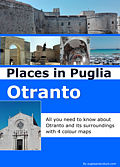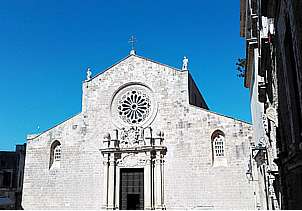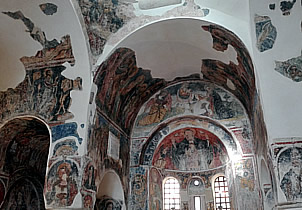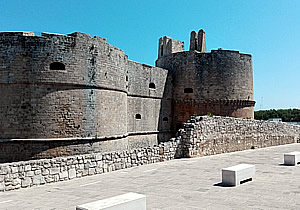Otranto
Ostuni
- Origins of Ostuni
- What to see in Ostuni
- Events in Ostuni
- Practicalities
- Seaside of Ostuni
- Masserie of Ostuni
- Trulli
- Museum of Ostuni
- Parks and protected areas
- Cuisine
- Images of Ostuni
- Ostuni local info
- Getting to Ostuni
Rentals
Services
- Property and land management
- Guest management
- Property restoration and reparing works
- Taxi service and taxi sharing service
- Services for disabled
Excursions
Food & Wine
Otranto...a bit of history
Otranto and its surroundings were already inhabited during the Bronze and Iron ages, as testified by the remains dating back to the Palaeolithic era, found near the town. The city was later colonised by the Messapians and by the Greeks. During the Roman rule it became a municipality and one of most important maritime cities of Puglia.
Like all southern Italian cities, especially those along the coast, Otranto was subject to continual attacks by the Turks. One of those attacks is still remembered today as one of the bloodiest ever. In 1480, an Ottoman army sent by Mehmed the Conqueror captured Otranto. Some 800 citizens, known as the "Martyrs of Otranto," were beheaded after refusing to convert to Islam. The following year, after causing much destruction, the Turks abandoned the town.
The small historic centre of Otranto, surrounded by imposing defensive walls, is a beautiful place, dominated by two main monuments: the Cathedral of the Annunciation and the Aragonese castle.
It is a historic town, with narrow streets, stairs and panoramic corners all along the high defensive walls.
Tourist Info Office
Address: Piazza Castello
Phone number: + 39 0836 801436
Distance from Ostuni: 124 km
Time to get there by car: about 1 hours and 30 minutes
Places in Puglia: Otranto
Get this fully comprehensive guide to enjoy the art and life in Otranto.

Full coverage of the history and art of Otranto, the surrounding territory, best restaurants, both within and outside the town, together with a range of pubs, bars, wine bars, pasticcerie, gelaterie and sport facilities. Shopping information, including handicrafts, local markets and organic food and wine shops. General information on transport, opening hours and other useful tips. All you need to know with 4 maps.
Ebook for Kindle, Ipad, Iphone, all smartphones, Tablets, PCs and Macs.
Get it from Amazon.co.uk or from Amazon.com
What to see in Otranto
The Cathedral of Santa Maria Annunziata

The Cathedral of Otranto, built on top of ancient Messapian and Roman settlements, was constructed during Norman rule, around the 12th century, and dedicated to Santa Maria Annunziata.
A unique feature of the cathedral is its Romanesque mosaic floor, created, using local materials, between 1163 and 1165 by a group of artists led by Pantaleone, a monk from the nearby monastery of San Nicola di Casole.
Chiesa di San Pietro

This church, located in the heart of the city, is an important example of Byzantine art in Puglia. It was built between the 9th and 10th centuries in the shape of a Greek cross, with four large columns that hold up a central dome. The interior of the church is decorated with a series of vivid Byzantine style frescoes, some dating back to the 10th century.
The Castle

The imposing Castle of Otranto was commissioned by Alfonso II of Naples, and built between 1485 and 1492 on the site of former Swabian fortifications. The original structure, with its circular towers and surrounding moat, was altered in 1578, with the addition of a diamond-shaped bastion, intended to identify marauding ships. The entrance to the castle, located in Piazza Castello, sports the coat of arms of Emperor Charles V.
Ostuni
- Origins of Ostuni
- What to see in Ostuni
- Events in Ostuni
- Practicalities
- Seaside of Ostuni
- Masserie of Ostuni
- Trulli
- Museum of Ostuni
- Parks and protected areas
- Cuisine
- Images of Ostuni
- Ostuni local info
- Getting to Ostuni
Rentals
Services
- Property and land management
- Guest management
- Property restoration and reparing works
- Taxi service and taxi sharing service
- Services for disabled
Excursions
Food & Wine







